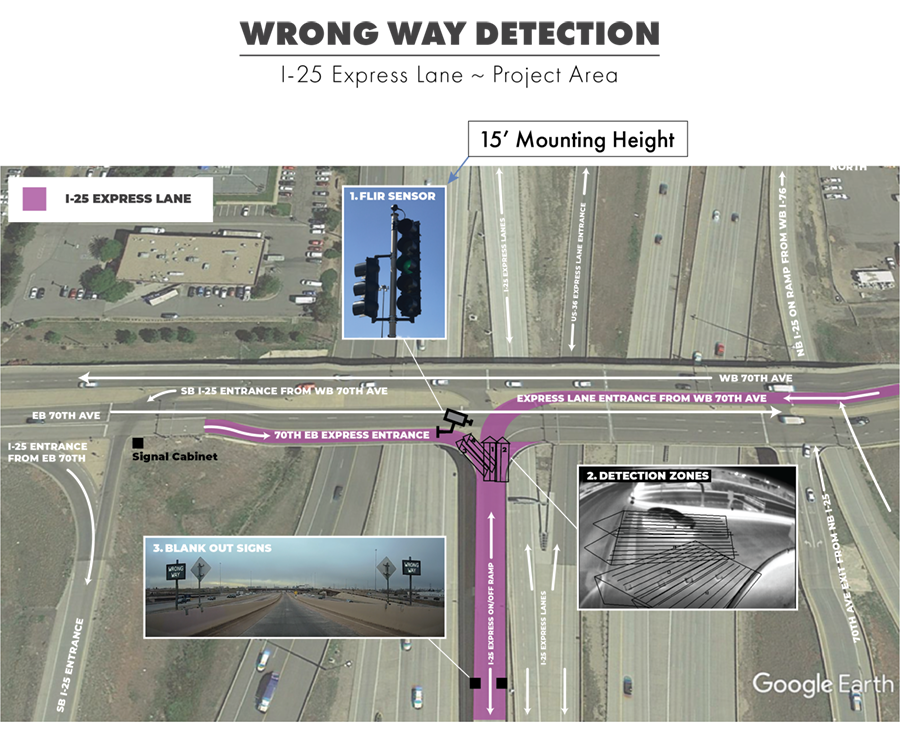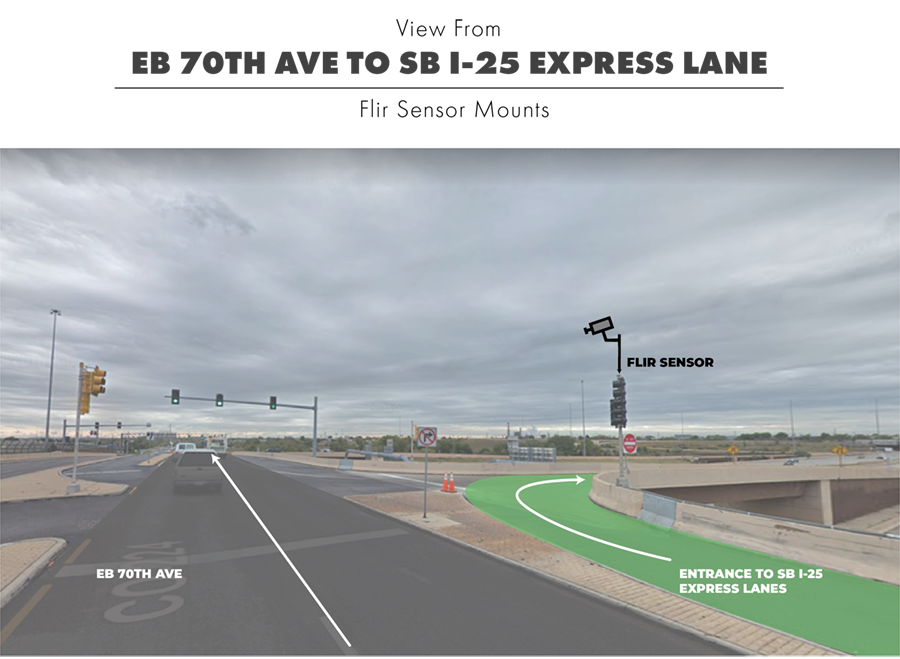By Navjoy
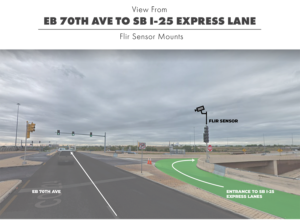
TrafiSense2 sensor
Region 1 initiated a pilot project to evaluate the accuracy of an FLIR TrafiSense2 thermal sensor installed at the ramp. Navjoy assisted with the evaluation by coordinating with the vendor to fine-tune the sensor’s detection zones and settings, conducting controlled tests, reviewing and categorizing wrong-way alerts, documenting discrepancies and inaccuracies, and summarizing results and lessons learned about the sensor’s deployment.
The sensor was paired with blank-out “Wrong Way” signs installed near the bottom of the ramp that illuminated for wrong-way drivers. During the roughly six-month evaluation period, the sensor generated 280 total alarms, 21 of which were legitimate wrong-way maneuvers. Alarms were the product of both controlled testing and uncontrolled detections. The process chart above shows how the TrafiSense2 responds to a wrong-way detection. The Wrong-Way Detection graphic below shows a map of the project site and location of the thermal sensor, detection zones, and blank-out signs.
The volume of alarms was due, in part, to the ramps being reversible by time of day. The sensor began sending alarms at 11:00 a.m. every day; however, gates that block access to the ramp at the start of the directional changeover period did not descend until approximately 11:06 a.m. Thus, many vehicles that turned onto the ramp during this interim period triggered an alarm but were not actually driving the wrong way.
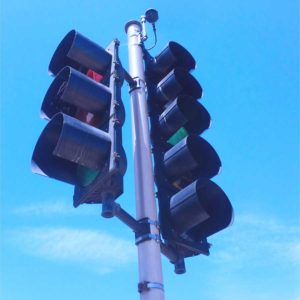
Navjoy reviewed each alarm and recorded the date/time of the alert, the vehicle type, the zone(s) triggered, if there were adverse weather conditions, if the vehicle took corrective action, if there were duplicate detections for a single vehicle, if a vehicle was not detected, and if the alarm latency was greater than one minute, among others.
Using that data, Navjoy found the sensor to be 92 percent accurate during the day and 94 percent accurate at night for a combined 94 percent accuracy rate in all conditions.
The evaluation revealed plenty of lessons about the thermal sensor’s capabilities and about wrong-way driving behaviors at the study location. Please note the lessons learned to best assess and prevent wrong-way drivers with a thermal sensor highlighted below are not exhaustive. It is intended to provide key insight and recommendations on this type of device.
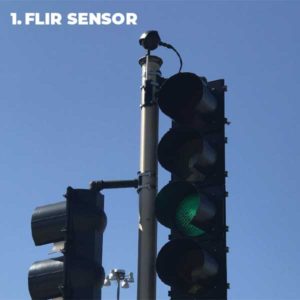
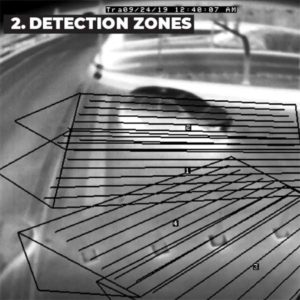

10 lessons learned during evaluation
- The sensor should be installed as close as possible to manufacturer’s specifications (mounting height, angle to road, etc.), given site conditions (Image One).
- Detection zones should overlap and be carefully calibrated based on unique site conditions to minimize missed detections (Image Two).
- Ideally, two sensors should be deployed – one for initial detection and one for confirmation that the wrong-way vehicle is not correcting.
- Wherever possible, the sensor should be connected to a high-speed fiber optic network to minimize alarm latency.
- It is best to pair a detection sensor with a secondary warning system, such as blank-out or blinking signs, to warn wrong-way drivers (Image Three).
- The location of the secondary warning system should provide enough time for motorists to clearly see it for at least a few seconds before driving past it.
- The thermal sensor should be paired with an optical camera to capture identifying information about the wrong-way vehicle (make, model, color, etc.) and collect more data on their maneuvers.
- The video clips sent with alarms should be adjusted to show more time after the wrong-way maneuver to capture if the wrong-way vehicle takes corrective action.
- The review of wrong-way alarms can inform future mitigation efforts. Knowing how wrong-way movements are made allows an agency to target specific issues
- Thermal sensors are subject to ambient infrastructure temperature interference which can cause a missed detection. Agencies should take careful note of this effect when deploying a thermal sensor.
Overall, this project was an exciting look into the future of wrong-way crash mitigation and the power of ITS technology. Working closely with our clients, we are excited to continue testing new technologies, such as automated incident detection using smart cameras within the I-25 South Gap project. Stay tuned for more project updates!
For questions and comments, contact us at communication@navjoyinc.com.
By Navjoy
Numerous agencies across the country are concerned about wrong-way drivers and the risks they pose to themselves and other motorists. Our client, Colorado Department of Transportation (CDOT) Region 1, expressed concern with the time-of-day reversible Express Lanes Ramp at I-25 and 70th Ave. in Denver, Colo. due to several wrong-way crashes at the location, some of which were fatal.
TrafiSense2 sensor
Region 1 initiated a pilot project to evaluate the accuracy of an FLIR TrafiSense2 thermal sensor installed at the ramp. Navjoy assisted with the evaluation by coordinating with the vendor to fine-tune the sensor’s detection zones and settings, conducting controlled tests, reviewing and categorizing wrong-way alerts, documenting discrepancies and inaccuracies, and summarizing results and lessons learned about the sensor’s deployment.
The sensor was paired with blank-out “Wrong Way” signs installed near the bottom of the ramp that illuminated for wrong-way drivers. During the roughly six-month evaluation period, the sensor generated 280 total alarms, 21 of which were legitimate wrong-way maneuvers. Alarms were the product of both controlled testing and uncontrolled detections. The process chart above shows how the TrafiSense2 responds to a wrong-way detection. The Wrong-Way Detection graphic below shows a map of the project site and location of the thermal sensor, detection zones, and blank-out signs.
The volume of alarms was due, in part, to the ramps being reversible by time of day. The sensor began sending alarms at 11:00 a.m. every day; however, gates that block access to the ramp at the start of the directional changeover period did not descend until approximately 11:06 a.m. Thus, many vehicles that turned onto the ramp during this interim period triggered an alarm but were not actually driving the wrong way.
Data analyzation

Using that data, Navjoy found the sensor to be 92 percent accurate during the day and 94 percent accurate at night for a combined 94 percent accuracy rate in all conditions.
The evaluation revealed plenty of lessons about the thermal sensor’s capabilities and about wrong-way driving behaviors at the study location. Please note the lessons learned to best assess and prevent wrong-way drivers with a thermal sensor highlighted below are not exhaustive. It is intended to provide key insight and recommendations on this type of device.



10 lessons learned during evaluation
- The sensor should be installed as close as possible to manufacturer’s specifications (mounting height, angle to road, etc.), given site conditions (Image One).
- Detection zones should overlap and be carefully calibrated based on unique site conditions to minimize missed detections (Image Two).
- Ideally, two sensors should be deployed – one for initial detection and one for confirmation that the wrong-way vehicle is not correcting.
- Wherever possible, the sensor should be connected to a high-speed fiber optic network to minimize alarm latency.
- It is best to pair a detection sensor with a secondary warning system, such as blank-out or blinking signs, to warn wrong-way drivers (Image Three).
- The location of the secondary warning system should provide enough time for motorists to clearly see it for at least a few seconds before driving past it.
- The thermal sensor should be paired with an optical camera to capture identifying information about the wrong-way vehicle (make, model, color, etc.) and collect more data on their maneuvers.
- The video clips sent with alarms should be adjusted to show more time after the wrong-way maneuver to capture if the wrong-way vehicle takes corrective action.
- The review of wrong-way alarms can inform future mitigation efforts. Knowing how wrong-way movements are made allows an agency to target specific issues
- Thermal sensors are subject to ambient infrastructure temperature interference which can cause a missed detection. Agencies should take careful note of this effect when deploying a thermal sensor.
Overall, this project was an exciting look into the future of wrong-way crash mitigation and the power of ITS technology. Working closely with our clients, we are excited to continue testing new technologies, such as automated incident detection using smart cameras within the I-25 South Gap project. Stay tuned for more project updates!
For questions and comments, contact us at communication@navjoyinc.com.


